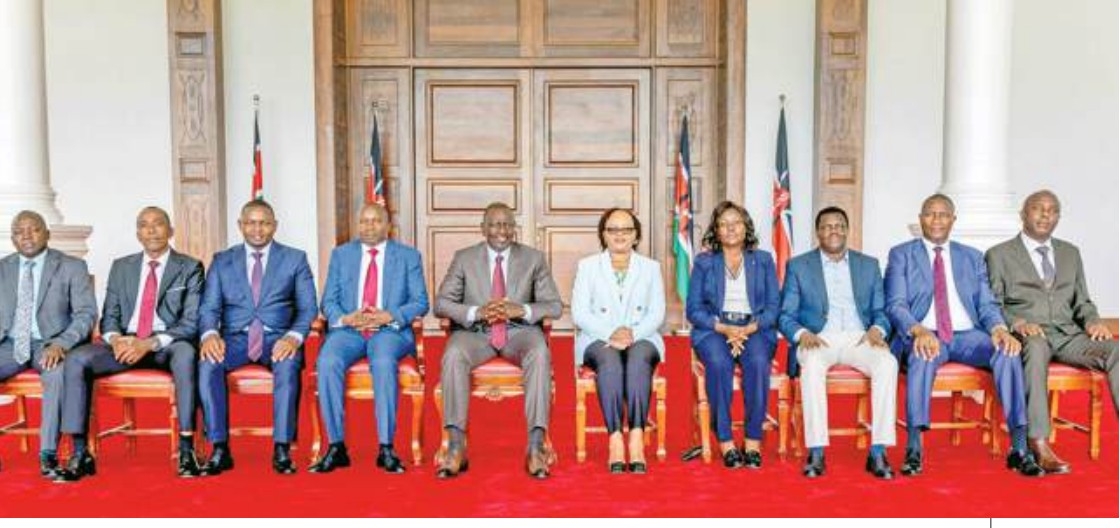County chiefs could be perpetuating the menace of ghost workers, a new report by the Controller of Budget shows.
The report shows that county governments still pay workers using manual payrolls, thus creating loopholes for siphoning cash.
The review for the year to June 30, 2023 showed that county governments paid Sh16 billion salaries through the manual system.
COB Margaret Nyakang’o said the situation goes against the requirement for all ministries, state departments, agencies and county governments to pay salaries through integrated personal payroll databases (IPPD).
“The manual payroll is prone to abuse and may lead to the loss of public funds where there is a lack of proper controls,” the Controller of Budget said.
The cases, according to the report tabled in Parliament recently, are spread across the 47 devolved units and account for seven per cent of the Sh208 billion wage bill.
The findings point to possibilities that unscrupulous officers could be taking advantage of the unregulated hiring of contract and casual workers.
Nairobi had the highest portion of the payouts at Sh2.5 billion, followed by Siaya, which paid some of its workers Sh1.1 billion using manual lists.
The findings could give a limb to concerns about the menace of ghost workers in the country, especially in county governments.
An audit ordered by Siaya Governor James Orengo on assuming office unmasked about 111 suspected ghost workers.
The taskforce chaired by the FCPA William Ouko, which was established in January 2023, said the problem was more pronounced in the hiring of casual workers.
Homa Bay county government was third with details showing it paid some workers Sh759 million outside the duly authorised payment system.
An audit by PriceWaterhouseCoopers exposed more than 1,780 ghost workers at Homa Bay. The lot was estimated to earn Sh300 million annually.
Nyakang’o said County Public Service Boards should regulate staff engagement on contract and casual workers as provided under Section 74 of the County Governments Act, 2012.
Wajir was also among counties with the highest amounts having paid Sh622 million through the highly doubted manual payroll.
Some of the questioned payments were stipends paid to Community Health Volunteers, County Youth Service and the Women’s Empowerment Programme.
Data from the Controller of Budget shows that Machakos county paid about Sh600 million manually followed by Nakuru and Busia at Sh582 million each, while Marsabit processed Sh562 million salaries manually.
In Laikipia, Sh528 million salaries were processed manually, Sh527 million in Kakamega, Sh507 million in Narok, and Sh480 million in Garissa.
Other counties with big payouts included Mombasa (Sh435 million), Nyeri (Sh413 million), Murang’a (Sh409 million), Bomet (Sh394 million), Makueni (Sh371 million), Uasin Gishu (Sh337 million) and Samburu (Sh319 million).
Mandera processed Sh288 million manual salaries, Nandi Sh271 million, Elgeyo Marakwet Sh266 million, Kiambu Sh261 million, Kilifi Sh257 million, Kajiado Sh245 million, Kisumu Sh236 million and Bungoma Sh231 million.
Twenty other counties had manual payrolls amounting to between Sh15 million (Tana River) and Sh190 million, the latter being the case of Lamu, escalating concerns about payments to phantom employees.
County governments are required to acquire unified personnel numbers (UPNs) for their staff, numbers which are to uniquely identify county staff on the prescribed government system.
Nyakang’o reported that all the devolved units are yet to fully incorporate their workforce into the system as required by regulations and government policy.
“County governments should fast-track the acquisition of Unified Personnel Numbers for their staff and ensure payroll is processed through the prescribed government system,” she said.
In West Pokot, an audit ordered by Governor Simon Kachapin revealed that more than 2,300 ghost workers had been drawing salaries from the county.
Kisii Governor Simba Arati also flagged 861 ghost workers in a purge that cut across all departments.
Last year, the Senate commissioned a probe to establish whether Vihiga county paid Sh55 million to ghost workers.
A probe by Machakos Governor Wavinya Ndeti also revealed that some staff had been earning salaries and allowances illegally.
Cases of employment of underage persons were among the anomalies cited in the review among cases of shared bank accounts.
In Elgeyo Marakwet, a report said 12 ‘people’ who were earning at the county were doing nothing or were non-existent.
Another 935 were smoked out in Kitui and 470 from the Trans Nzoia county government's official payments system.
Wage bill concerns dominated a forum the Salaries and Remuneration Commission held earlier in the year.
Among the issues that featured included the breach of the requirement that salaries should not be more than a third of county revenues.
In the year ending June 30, 2023, only three counties had their personnel expenditure within the 35 per cent ceiling, being Kilifi, Tana River and Narok.
Nyakang’o said county governments should ensure that expenditure on personnel emoluments is contained at sustainable levels.
The Public Finance Management (County Governments) Regulations, 2015, limits the county government’s expenditure on wages and benefits to 35 per cent of the county’s total revenue.
The Controller of Budget asked governors, county assemblies and officers responsible for hiring of staff to observe strict compliance with the approved staff establishment.
Early this year, the government unveiled a new HR system to consolidate payroll data in the public service through a single warehouse.
All state agencies, including state corporations, commissions and independent offices, have been linked to the system.
The existence of ghost workers has also been cited in the case of the national government.
Public Service Commission in its latest review unmasked 20,000 ghost workers in the state payroll.
PSC revealed that there was an excess of 19,467 workers, including at State House and New Kenya Cooperative Creameries (New KCC).
Six organisations were found with high disparities with an excess of more than 100 staffers compared to those recorded in the staff register.
“The unexplained variance could create room for unauthorised recruitment of staff,” PSC said in its compliance report for the year 2023.













![[PHOTOS] Three dead, 15 injured in Mombasa Rd crash](/_next/image?url=https%3A%2F%2Fcdn.radioafrica.digital%2Fimage%2F2025%2F11%2Fa5ff4cf9-c4a2-4fd2-b64c-6cabbbf63010.jpeg&w=3840&q=100)

